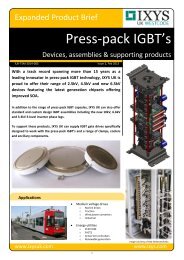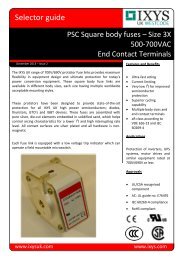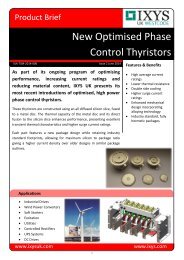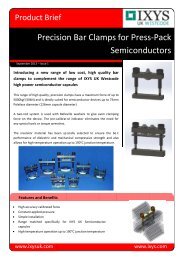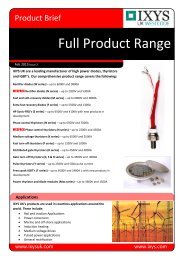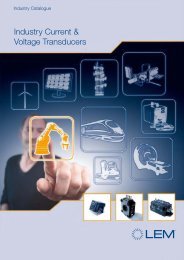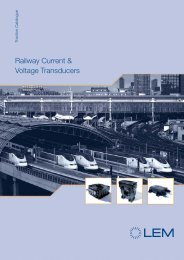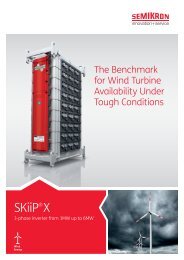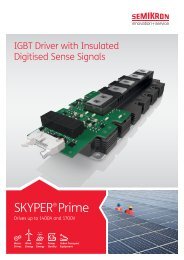isolated current voltage transducers
Create successful ePaper yourself
Turn your PDF publications into a flip-book with our unique Google optimized e-Paper software.
Hall Effect Technologies<br />
Demagnetization <strong>current</strong><br />
> 5 cycles<br />
> 30 cycles<br />
• core losses become significant at high frequencies and it<br />
is essential to limit the <strong>current</strong> amplitude at these<br />
frequencies to acceptable levels (dependent on ambient<br />
and maximum transducer temperatures); this implies not<br />
only limiting the maximum frequency of the fundamental<br />
<strong>current</strong>, but also harmonic content, since even a low<br />
amplitude signal may create unacceptable losses at high<br />
frequencies.<br />
3.1.7.2 Core loss rule-of-thumbs<br />
Iron losses calculation are complex and, as a „rule-of-thumb“<br />
judgment, it is possible to consider that the iron losses are<br />
minimized if the product "N • I • f" is kept as small as<br />
possible, where:<br />
Figure 5: Degauss cycle <strong>current</strong><br />
Alternatively, a partial demagnetization of the core is possible<br />
by providing an appropriate signal in the opposite polarity of<br />
the magnetization. The difficulty is determining the exact<br />
amplitude and duration to obtain a satisfactory result. With a<br />
well-defined application it may be feasible to determine the<br />
required value empirically and apply this correction as<br />
necessary.<br />
3.1.7 Bandwidth and core losses<br />
The bandwidth limitation of open loop <strong>transducers</strong> is mainly<br />
due to two factors:<br />
• limitations of the processing electronics<br />
• magnetic core heating due to core losses, a combination of<br />
eddy <strong>current</strong> and hysteresis losses<br />
3.1.7.1 Core losses<br />
The magnetic material and core design as well as the <strong>current</strong><br />
amplitude versus frequency spectra define the level of core<br />
losses:<br />
• eddy <strong>current</strong> losses are proportional to the square of three<br />
different parameters: the peak flux density in the core, the<br />
frequency of induction and the lamination sheet thickness<br />
of the core<br />
• hysteresis losses are proportional to frequency, core<br />
volume and the square of peak flux density<br />
For LEM <strong>transducers</strong>, this leads to the following conclusions:<br />
• these losses are directly proportional to the square of the<br />
flux density, which is directly related to the primary ampereturns,<br />
implying core losses are theoretically proportional to<br />
the square of primary ampere-turns if no magnetic<br />
saturation occurs. When increasing sensitivity by using<br />
multiple primary turns, core losses are increased by the<br />
square of the turns<br />
N = number of internal or external primary turns<br />
I = primary <strong>current</strong> or amplitude of a <strong>current</strong> harmonic<br />
f = frequency of the primary <strong>current</strong> or <strong>current</strong> harmonic<br />
As a result, when one of the three factors is increased (i.e.<br />
the <strong>current</strong>), the iron losses are increased unless at least<br />
one of the two other factor is decreased (i.e. the frequency of<br />
the measured <strong>current</strong> and/or the number of primary turns).<br />
While this formula implies that the core losses will increase<br />
with an increase of any of these parameters, it is not<br />
intended to say that acceptable core losses are realized if<br />
the product of the three parameters is kept constant. For<br />
example, it is wrong to say that one can operate at twice the<br />
frequency if the Ampere-turns are cut in half.<br />
At a given frequency, it is nevertheless correct to assume<br />
that keeping constant the "N • I" product implies similar iron<br />
losses, even the probable change on the primary conductor<br />
magnetic coupling may affect the iron losses value.<br />
To conclude, trouble-free operation of a <strong>current</strong> transducer<br />
requires limiting the temperature rise to avoid overheating<br />
the internal components. Parameters affecting temperature<br />
rise go beyond core losses and include the primary busbar<br />
resistive losses, the losses of the electronics and the various<br />
thermal resistances. In particular, to keep losses constant<br />
requires to decrease the transducer primary <strong>current</strong> while<br />
the working frequency increases.<br />
3.1.7.3 A core loss example<br />
Considering the LEM open loop HY 10-P transducer, where<br />
the primary is integrated into the transducer and the number<br />
of primary turns cannot be changed, tests show the following<br />
maximum working conditions:<br />
11





